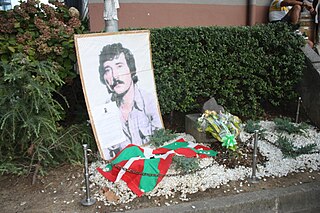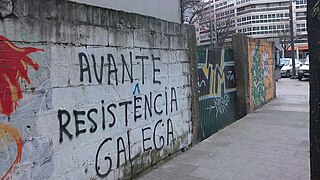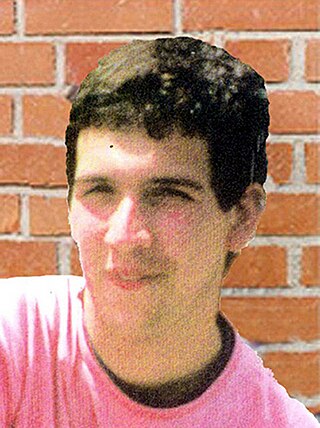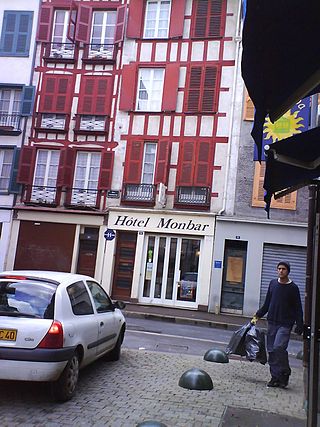
The Ertzaintza is the autonomous police force for the Basque Country, largely replacing the Spanish Policía Nacional and Guardia Civil. An Ertzaintza member is called an ertzaina.

GAL were death squads illegally established by officials of the Spanish government during the Basque conflict to fight against ETA, the principal Basque separatist militant group. They were active from 1983 to 1987 under Spanish Socialist Workers' Party (PSOE)-led governments.

Getxo is a town located in the province of Biscay, in the autonomous community of the Basque Country, in Spain. It is part of Greater Bilbao, and has 75,430 inhabitants (2023). Getxo is mostly an affluent residential area, as well as being the third largest municipality of Biscay.
Iraultza was a small Basque militant armed group of leftist tendency, active between 1982 and 1996 as a response to the suppression of the Basque resistance movement. It was thought to be a group of less than 50 people based in Bilbao, largely focused on the destruction of property, particularly those of American multinational corporations and against other smaller Spanish companies involved in labor disputes, in support of Workers' self-management and mobilization, although one of its attacks was responsible for the death of one individual and several for minor injuries of others. According to newspaper El País it was thought to be responsible for over 210 attacks during its existence.

On 30 December 2006, a van bomb exploded in the Terminal 4 parking area at the Madrid–Barajas Airport in Spain, killing two and injuring 52. On 9 January 2007, the Basque nationalist and separatist organisation ETA claimed responsibility for the attack. The attack, one of the most powerful carried out by ETA, damaged the airport terminal and destroyed the entire parking structure. The bombing ended a nine-month ceasefire declared by the armed organisation and prompted the government to halt plans for negotiations with the organisation. Despite the attack, ETA claimed that the ceasefire was still in place and regretted the death of civilians. The organisation eventually announced the end of the ceasefire in June 2007.
The controversy regarding the handling and representation of the Madrid train bombings by the government arose with Spain's two main political parties, Spanish Socialist Workers' Party (PSOE) and Partido Popular (PP), accusing each other of concealing or distorting evidence for electoral reasons.
ETA's 2006 "permanent ceasefire" was the period spanning between 24 March and 30 December 2006 during which, following an ETA communiqué, the Spanish government, led by José Luis Rodríguez Zapatero on one side, and the militant group on the other, engaged in talks as a means to agree on a formula to voluntarily disband the latter. It was terminated as a result of the 2006 Madrid Barajas International Airport bombing.
Jurdan Martitegi Lizaso is a member of the armed Basque nationalist group Euskadi Ta Askatasuna (ETA). He is best known as the head of the military/commando unit of the group since late 2008 until April 18, 2009, when he was arrested by French police. He is considered to be one of the most dangerous members of ETA, considered a terrorist organization by the European Union, with police describing him as "extremely violent".

A van bomb carrying more than 300 kg of explosive went off on 29 July 2009 outside a Civil Guard barracks in the northern city of Burgos, Spain, injuring at least 65 people. The attack was blamed on Basque separatist group Euskadi Ta Askatasuna (ETA). Several children were among the 65 wounded in the attack.
The 2009 Palma Nova bombing occurred on 30 July 2009, when a limpet bomb went off outside a Civil Guard barracks in the town of Palma Nova, Majorca, Spain. The bomb was placed under a patrol car and two Civil Guard officers died as a result of the explosion. A second device was found under another Civil Guard vehicle at nearby barracks and safely exploded by police. On 9 August, the Basque nationalist and separatist organisation ETA claimed responsibility for the attack, while four other bombs exploded around restaurants and shopping centres in Palma, Majorca, causing no injuries.

Resistência Galega, sometimes referred to as REGA, is the term used by a series of left-wing and Galician separatist organisations and individuals to claim attacks in Galicia. The term was first used in 2005 when a manifesto named Manifesto da Resistência Galega appeared on the Internet. Since then, Resistência Galega has carried out dozens of attacks against political party offices and banks across Galicia.

Arkaitz Goikoetxea Basabe is a member of the Basque separatist organisation ETA. He began his violent activity at the age of 15 as a member of the street violence groups known as kale borroka. He was arrested several times between 2001 and 2002, and joined ETA in 2005.
The July 1979 Madrid bombings were a series of bomb attacks carried out by ETA political-military (ETA-pm), a faction of the armed Basque separatist group ETA. The attacks, consisting of coordinated bombings in Barajas Airport and the train stations of Atocha and Chamartín, killed 7 people and injured a further 100. The bombings occurred a day after two attacks in Bilbao and San Sebastian, with both attacks killing two people.
The 1993 Madrid bombings were a coordinated attack of two car bombs by the armed Basque separatist group Euskadi Ta Askatasuna (ETA) in Madrid, Spain on 21 June 1993, killing 7 people and injuring a further 29. The target was an army vehicle transporting members of the army, killing six military passengers and the civilian driver. This was the deadliest attack of 1993 attributed to ETA.

A car bombing was carried out by the armed Basque separatist group ETA in Sabadell, Catalonia, Spain on 8 December 1990.
The October 1978 Getxo attack was a mass shooting gun attack by the Basque separatist organisation ETA which occurred on 22 October in the Basque town of Getxo, a suburb of Bilbao. The attack occurred six weeks before a referendum to approve a new Spanish constitution.

The Monbar Hotel attack was carried out by the Grupos Antiterroristas de Liberación (GAL), a Spanish state-sponsored death squad, on 25 September 1985 in Bayonne, Pyrénées-Atlantiques, France. The targets were four members of the Basque separatist terrorist group Euskadi Ta Askatasuna (ETA), whom the Spanish government believed to be senior figures in the organization, itself proscribed as a terrorist group in Spain and France. All four people were killed, with a fifth person, apparently unconnected to ETA, injured in the shooting. This represented the deadliest attack carried out by the GAL. Although two of the participants were apprehended shortly after the shooting, controversy surrounded the possible involvement of senior figures in the Spanish police.
The assassination of Augusto Unceta Barrenechea was an attack by the Basque separatist group ETA which took place on 8 October 1977 in Guernica in the Basque Country in northern Spain.
The Alianza Apostólica Anticomunista was a Spanish far-right paramilitary organisation active from 1976 to 1983, primarily in the southern Basque Country but also in the French Basque Country and Barcelona. A June 2010 report by the Office for Victims of Terrorism of the Basque Government attributed eight murders with 66 deathly victims to the group and linked it to the National Police Corps, SECED and the Civil Guard. The group attacked the satirical magazine El Papus in Barcelona, killing one person and injuring 17.











